Marañon Dry Forests
The ecoregion’s land area is provided in units of 1,000 hectares. The conservation target is the Global Safety Net (GSN1) area for the given ecoregion. The protection level indicates the percentage of the GSN goal that is currently protected on a scale of 0-10. N/A means data is not available at this time.
Bioregion: Andean Mountain Forests & Valleys (NT11)
Realm: Southern America
Ecoregion Size (1000 ha):
1,140
Ecoregion ID:
479
Conservation Target:
54%
Protection Level:
1
States: Peru
The Marañón spinetail is a relatively small species of bird and is completely restricted to the Marañon Valley in Peru and adjacent Ecuador. Their cinnamon coloured back and wings and grey body blend in well in the understory and dry leaves. Although very little is known of this rare and elusive spinetail, it prefers the deciduous forests and shrublands where it hunts for insects. They are known to forage through the forest undergrowth in pairs, where they benefit by working together to “scare up” some food.

The flagship species of the Marañon Dry Forests ecoregion is the yellow faced parrotlet. Image credit: Creative Commons
The Marañon Dry Forests ecoregion extends along the upper Marañon River valley and its tributaries in northwestern Peru. This ecoregion ranges from around 500m up to 2,000 m and is located between the central and northern Andes Mountains. A dry climate exists and is caused by a rain shadow effect from the mountains to the east, creating a unique habitat for tropical deciduous forest in addition to arid and riparian scrub.
Vegetation in this ecoregion consists of dry tropical forest characterized by desert scrub, including the cactus Prosopis; thick herbaceous scrub with small Acacia and cacti; seasonally dry forest with Ceiba primarily mixed with Acacia and Prosopis; and riparian forests consisting of Salix and Schinus.
Because of the unique structure of habitat and the biogeographic boundaries in the Andes Mountains, the Marañon valley has a large number of endemic bird species and therefore has been classified as an Endemic Bird Area. There are 22 restricted range species, and 11 are endemic to this ecoregion. Some examples include Marañon spinetail, Marañon crescent-chest, Marañon thrush, the vulnerable yellow-faced parrotlet and Marañon pigeon, and the endangered purple-backed sunbeam.
Nine key conservation areas have been identified based on threatened species in this Endemic Bird Area. Much of the ecoregion does not have any formalized protection. There is little further information to describe the current status of the newly delineated ecoregion at this time.
The Marañon River valley has been under agricultural pressure for many years. As a result, much of the habitat has been altered and is gradually deteriorating. Like many other ecoregions, this area is threatened by logging and cattle ranching. The priority conservation actions for the next decade will be to: 1) formalize and increase the number of protected areas over a range of habitats; 2) integrate sustainable methods into the logging and farming industries; and 3) limit the ecological footprint of future hydroelectric dams.
Citations
1. Locklin, C. 2019. Western Peru, in the upper Marañon River. https://www.worldwildlife.org/ecoregions/nt0223 Accessed June 26, 2019.
2. Birdlife International 2003 Birdlife’s online World Bird Database: the site for bird conservation. Version 2.0. Cambridge, UK: Birdlife International. Available: http://www.birdlife.org (accessed 21/4/2005).
3. Collar, N.J., L.P. Gonzaga, N. Krabbe, A. Madroño-Nieto L.G. Naranjo, T.A. Parker, and D.C. Wege. 1992. Threatened birds of the Americas. The ICBP/IUCN red data book, part 2. Third edition. International Council for Bird Preservation, Cambridge, England.
4. BirdLife International 2018. Synallaxis maranonica. The IUCN Red List of Threatened Species 2018: e.T22702350A130654683. http://dx.doi.org/10.2305/IUCN.UK.2018-2.RLTS.T22702350A130654683.en. Accessed June 27, 2019.



